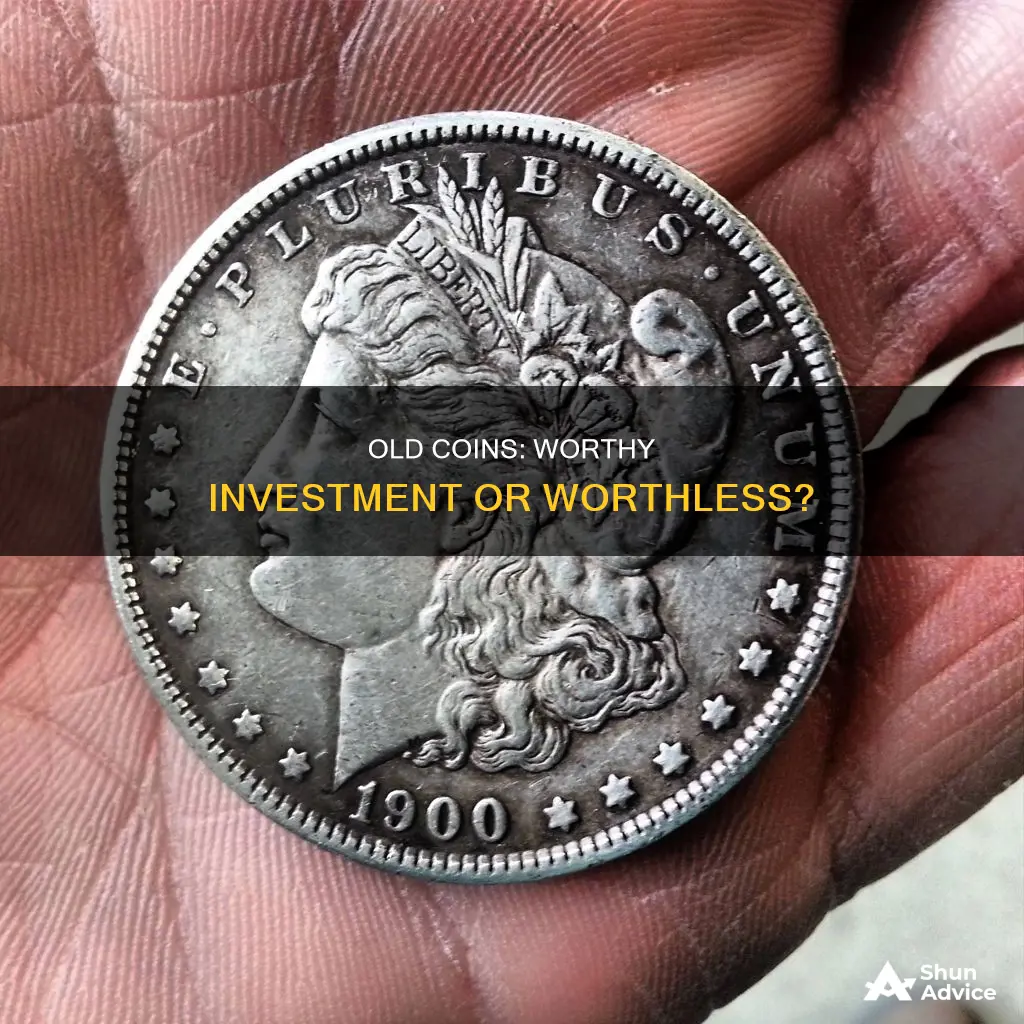
Coin collecting is a popular hobby for many, but is investing in old coins a good idea? Well, it can be, but it's not without risk.
Coins derive their value from two sources: the bullion value, or the value of the metal they contain, and their collector or numismatic value. The latter is harder to determine and depends on buyer sentiment, but generally, the fewer examples of a coin that were minted, the higher its collector value. The condition of the coin also plays a major role in its collector value.
Coins can be a good way to diversify your portfolio and reduce risk, and they are becoming an increasingly popular investment vehicle for those wary of the stock market or tired of its fluctuations. They are also a tangible asset that can be stored at home, rather than existing only on paper.
However, there are many scams in the world of coin investment, and it can be hard to gauge what the collector market for a particular coin will look like in the future. It's also important to remember that, as with any hobby, it's good to keep coin collecting fun!
What You'll Learn

Coins as bullion vs numismatics
Coins as bullion or numismatics is a distinction that investors need to understand before investing in old coins. Bullion coins are acquired for their precious metal content, whereas numismatic coins are sought for their rarity and not so much for their actual metal content.
Bullion Coins
Bullion coins are gold and silver coins purchased for investment, inflation hedge, or survival. The weight of a bullion coin is expressed as an even amount, such as 1 ounce or 1/2 ounce, and they are manufactured year after year. Examples of bullion coins include Canadian Gold Maples, South African Krugerrands, and American Gold Eagles. Bullion coins have a higher "melt value", meaning the value of the metal if it were melted down.
Numismatic Coins
Numismatic coins, on the other hand, are considered collectibles and are not produced in modern times. They are valued primarily for their rarity and historical significance, and not for their metal content. Numismatic coins are generally worth more than their metal content. Examples of numismatic coins include pre-1933 $20, $10 Eagle coins and Peace Silver Dollars.
The choice between investing in bullion or numismatic coins depends on the investor's goals. Numismatic coins often carry a larger risk and have huge premiums, whereas bullion coins have intrinsic value due to their gold or silver content. Bullion coins are also easier to sell when it's time to cash in on an investment. However, numismatic coins can be a good investment if one selects carefully and plans to hold on to them for the long term.
Understanding Bitcoin Investment Tax Deductions
You may want to see also

Rare coins as a commodity-like investment
Rare coins are considered a commodity-like investment, where sentimental value may exist, but they are one of the few tangibles that can also produce attractive financial returns. Coin collecting is an investment almost anyone can make. For serious investors, coins are a tangible asset that will provide diversity in a portfolio and hedge against inflation as the value of rare coins is generally stable.
Coins are also a great option for those interested in owning a tangible piece of history. Coins reveal an immense amount of information about our world and its civilizations. They are generally more accessible than larger, tangible asset investments.
There are two main types of coin investments: bullion and numismatics. Bullion has a higher "melt value", or the value the metal would be worth if melted down. Numismatic coins, because they are often much older and made of various metals and components, have a lower melt value. They are worth less when melted than they are in coin form.
According to the American Numismatic Association (ANA), investors who acquire coins for monetary growth alone often focus on precious metals. Those with a greater interest in numismatics may also pursue their investment with a collector's spirit, looking for specific pieces or series.
The general rule is to "buy bullion for business, numismatics for fun".
When investing in rare coins, it is important to specialize your investment selection. Choose a particular theme, time period, or emperor/ruler and use it to guide how you invest. Stay focused on a particular concentration and build within that. Even a small collection can be valuable, but that's less likely if you're all over the place.
It is also crucial to scrutinize each addition to your collection. Don't pick randomly; know what you're looking for and examine coins carefully to make sure they fit within the direction you're taking your collection.
Condition is everything when dealing in coins. It is also very subjective. Coin grading companies started "slabbing" coins, where, for a fee, they rate the condition of a coin and seal it inside a plastic slab along with a certificate of authenticity. Slabbing helps protect the coin and makes it easier to buy and sell, but it is not perfect and there can still be mistakes in the grading.
Every run of coins has "key dates", or dates and mint marks that are difficult to obtain. These are usually the last coins a collector will fill into their set and are great investment pieces because they are easy to sell.
When investing in coins, it is important to buy slabs, buy key dates to keep your count of coins low, build a relationship with a dealer, and have a safe place for storage.
Coin collecting can be a profitable venture when done right, but it is important to approach it as a hobby first and foremost, and to enjoy the historical significance and beauty of the coins.
The Crypto Investment Guide: Getting Started
You may want to see also

Key dates and mint marks
The rarity of a key date coin is influenced by factors such as demand, the quantity of coins struck, the population of surviving examples, and the rarity of mint state examples. The cost of obtaining key date coins in a series is typically the most expensive.
One example of a key date coin is the 1909-S VDB Lincoln Cent, which is considered rare due to its low mintage of 484,000. Another example is the 1893-S Morgan Dollar, which was struck at the United States San Francisco Mint with a mintage of only 100,000 coins, making it the lowest mintage of any business strike Morgan Dollar.
Mint marks are letters that identify where a coin was made and hold the maker responsible for the coin's quality. In the United States, mint marks were established by a Congressional Act on March 3, 1835, along with the first Mint branches in Charlotte, Dahlonega, and New Orleans. The mint marks first appeared on U.S. coins in 1838, with the letters indicating the respective branch ("C" for Charlotte, "D" for Dahlonega, and "O" for New Orleans).
Over time, the locations and appearances of mint marks on U.S. coins have changed. For example, the "P" mint mark for Philadelphia first appeared during World War II when nickel was removed from five-cent coins. After the war, the "P" mint mark was no longer used until it reappeared on the Susan B. Anthony dollar coin in 1979 and subsequent denominations (except the cent).
In addition to the "P" and previously mentioned mint marks, the "S" mint mark for the San Francisco Mint and the "W" mint mark for the West Point Bullion Depository have also been used on circulating coins at various points in history.
When investing in rare coins, it is important to consider key dates and mint marks as they significantly impact a coin's value and desirability for collectors.
Bitcoin Stock Investment: A Guide to Getting Started
You may want to see also

Slabbed coins
The term "slab" is slang for any type of holder that third-party grading services use after they professionally authenticate and grade a coin. Slabbed coins are coins that have been submitted to a professional grading service for certification and are examined by experts who assign a grade based on several factors. The slabbing process was introduced in 1986 by the Professional Coin Grading Service (PCGS) and has since been used by the Numismatic Guaranty Corporation of America (NGC), the two leading third-party grading services.
The slabbing process involves sonically sealing coins in a clear "slab" or holder, which includes essential information such as the coin's type, grade, variety, mint mark, and the third-party grading service's information. Slabbed coins are intended to be permanent holders and are usually difficult to tamper with once sealed.
There are several advantages to slabbing coins. Firstly, it offers protection against physical damage from normal wear and tear or being dropped. Secondly, slabbed coins provide a higher level of assurance when it comes to authenticity and resale value, reducing the need for further inspection when selling to a coin dealer. Lastly, slabbed coins remove subjectivity regarding the grade and, subsequently, the value of the coin.
However, it is important to note that silver and copper coins may still be damaged by toning if the container is not airtight. Additionally, the primary disadvantage of slabbing coins is the cost, which can range from $10 to $30 or more. Despite this, many experts highly recommend that any valuable or rare coins be submitted to one of the top-tier third-party grading services, such as PCGS or NGC.
In summary, slabbed coins offer the best protection for valuable or rare coins, providing authentication, grading, and a durable holder. While there is a cost associated with this process, it can be a worthwhile investment to maximise the value and protection of a coin collection.
Which Educational Institutions Embrace Bitcoin?
You may want to see also

Coin grading
The Sheldon grading scale, developed by renowned numismatist Dr William Sheldon in 1948, is the industry-standard scale used for coin grading. The scale assigns grades from 1 to 70, with a "70" coin being worth 70 times as much as a "1". The higher the numeric grade, the better the condition of the coin.
The Professional Coin Grading Service (PCGS) and the Numismatic Guaranty Company (NGC) are two well-known organisations that use the Sheldon grading scale. They provide expert authentication and grading services for rare coins, encapsulating graded coins in tamper-evident holders to ensure maximum security and peace of mind for collectors.
NGC uses two-letter codes before the numeric grade to describe the coin's method of production and overall appearance. The most common codes are MS for Mint State coins (struck for circulation) and PF for Proof coins (struck for collectors). NGC also uses Plus and Star designations to recognise coins with exceptional eye appeal for their assigned grade.
PCGS, on the other hand, provides five primary coin grading submission types, including authentication and grading of coins, regrading of raw coins, and improving the value and security of coins graded by other companies.
Best Bitcoin ETFs: Where to Invest Your Money
You may want to see also







